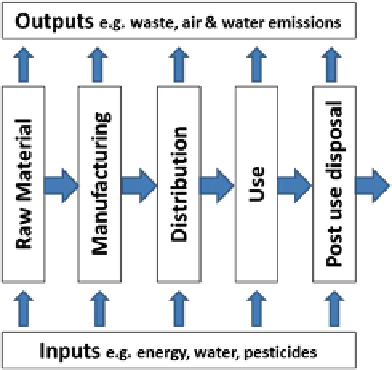Agriculture Reference
In-Depth Information
Fig. 15.3
A schematic
representation of a Life Cycle
Assessment, showing how
inputs and outputs interact
with the flow of product
development
Applying water to crops below their full requirements, or only replacing the
equivalent water lost through evapotranspiration, is of increasing interest to the hor-
ticultural industry. Known as deficit irrigation, various methods such as Partial Root
Drying (PRD) and Regulated Deficit Irrigation (RDI) have been found to encour-
age both above and below ground biomass through activating water stress survival
mechanisms (Wakrim et al.
2005
). Sub-optimal water supply can also improve hor-
ticultural crop quality (Turner
1990
), harden field crops off within the nursery prior
to transplantation, reduce dispersal of water-borne diseases and run-off or potential
contamination into water courses, and reduce evaporation loss through precision
application using drip line irrigation.
Wetlands
Horticultural farms as well as using water for irrigation, also produce significant
amount of waste water from their packhouses. Such sources may contain small
quantities of detergents, soaps, post-harvest preservatives, dilute pesticides and
sterilants. Clearly this water cannot be disposed of directly into water courses yet
cleaning such water can be potentially costly. A solution that is increasing in popu-
larity particularly in Kenya is the wetland system. A wetland is a single or series of
lagoons that have a gravel base where plants grow. The water passes through the
lagoon and is purified by the activity of the bacteria and algae attached to the sub-
strate and the plant roots (Fig.
15.3
). The biological processes at work in a wetland
are complex and interacting but involve algae, bacteria and plants and the process is
also called phytoremediation or bioremediation (Fig.
15.4
).
Wetlands come in many shapes and sizes but keys to success are that the water
must progress from one end to the other end and not be allowed to “short circuit”
the journey through the wetland. Also the water should not be able to pass through

